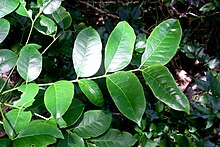| Yellow wood | |
|---|---|

| |
|
Scientific classification
| |
| Kingdom: | Plantae |
| Clade: | Tracheophytes |
| Clade: | Angiosperms |
| Clade: | Eudicots |
| Clade: | Rosids |
| Order: | Sapindales |
| Family: | Rutaceae |
| Genus: | Zanthoxylum |
| Species: | Z. pinnatum
|
| Binomial name | |
| Zanthoxylum pinnatum | |
| Synonyms [1] | |
|
List
| |
Zanthoxylum pinnatum, commonly known as yellow wood, [2] is a species of flowering plant of the family Rutaceae native to Lord Howe and Norfolk Islands. It is a tree with pinnate leaves, white male and female flowers arranged in groups in leaf axils, and spherical, purple follicles containing a single black seed.
Description
Zanthoxylum pinnatum is a tree that typically grows to a height of 10 m (33 ft). Its leaves are pinnate, usually with four to nine oblong to egg-shaped, slightly curved leaflets, mostly 50–80 mm (2.0–3.1 in) long and 30–45 mm (1.2–1.8 in) wide. The flowers are arranged in small to large groups in leaf axils with separate male and female flowers, the four sepals egg-shaped and 0.5–1 mm (0.020–0.039 in) long, the four or five petals white, lance-shaped and 2.5–3 mm (0.098–0.118 in) long. Flowering occurs from February to March and the fruit is a spherical, purple follicle about 8 mm (0.31 in) long containing a single black seed. [2] [3]
Taxonomy
Yellow wood was first formally described in 1775 by Johann Reinhold Forster and Georg Forster who gave it the name Blackburnia pinnata in their book Characteres Generum Plantarum. [4] [5] In 1917, Walter Oliver changed the name to Zanthoxylum pinnatum in Transactions and Proceedings of the New Zealand Institute. [6]
Distribution and habitat
Zanthoxylum pinnatum grows in forest on Lord Howe and Norfolk Islands but is not common on either island. [2] [3]
References
- ^ a b "Zanthoxylum pinnatum". Australian Plant Census. Retrieved 18 August 2020.
- ^ a b c "New South Wales Flora Online: Zanthoxylum pinnatum". Royal Botanic Gardens & Domain Trust, Sydney, Australia.
- ^ a b Hartley, Thomas G. (2013). Annette J.G. Wilson (ed.). Flora of Australia (Volume 26). Canberra: Australian Biological Resources Study. p. 252. Retrieved 19 August 2020.
- ^ "Blackburnia pinnata". APNI. Retrieved 19 August 2020.
- ^ Forster, Johann R.; Forster, Georg (1775). Characteres Generum Plantarum. London: Prostant apud B. White, T. Cadell, & P. Elmsly,1776. pp. 11–12. Retrieved 19 August 2020.
- ^ Oliver, Walter (1917). "The vegetation and flora of Lord Howe Island". Transactions and Proceedings of the New Zealand Institute. 49: 140. Retrieved 19 August 2020.
| Yellow wood | |
|---|---|

| |
|
Scientific classification
| |
| Kingdom: | Plantae |
| Clade: | Tracheophytes |
| Clade: | Angiosperms |
| Clade: | Eudicots |
| Clade: | Rosids |
| Order: | Sapindales |
| Family: | Rutaceae |
| Genus: | Zanthoxylum |
| Species: | Z. pinnatum
|
| Binomial name | |
| Zanthoxylum pinnatum | |
| Synonyms [1] | |
|
List
| |
Zanthoxylum pinnatum, commonly known as yellow wood, [2] is a species of flowering plant of the family Rutaceae native to Lord Howe and Norfolk Islands. It is a tree with pinnate leaves, white male and female flowers arranged in groups in leaf axils, and spherical, purple follicles containing a single black seed.
Description
Zanthoxylum pinnatum is a tree that typically grows to a height of 10 m (33 ft). Its leaves are pinnate, usually with four to nine oblong to egg-shaped, slightly curved leaflets, mostly 50–80 mm (2.0–3.1 in) long and 30–45 mm (1.2–1.8 in) wide. The flowers are arranged in small to large groups in leaf axils with separate male and female flowers, the four sepals egg-shaped and 0.5–1 mm (0.020–0.039 in) long, the four or five petals white, lance-shaped and 2.5–3 mm (0.098–0.118 in) long. Flowering occurs from February to March and the fruit is a spherical, purple follicle about 8 mm (0.31 in) long containing a single black seed. [2] [3]
Taxonomy
Yellow wood was first formally described in 1775 by Johann Reinhold Forster and Georg Forster who gave it the name Blackburnia pinnata in their book Characteres Generum Plantarum. [4] [5] In 1917, Walter Oliver changed the name to Zanthoxylum pinnatum in Transactions and Proceedings of the New Zealand Institute. [6]
Distribution and habitat
Zanthoxylum pinnatum grows in forest on Lord Howe and Norfolk Islands but is not common on either island. [2] [3]
References
- ^ a b "Zanthoxylum pinnatum". Australian Plant Census. Retrieved 18 August 2020.
- ^ a b c "New South Wales Flora Online: Zanthoxylum pinnatum". Royal Botanic Gardens & Domain Trust, Sydney, Australia.
- ^ a b Hartley, Thomas G. (2013). Annette J.G. Wilson (ed.). Flora of Australia (Volume 26). Canberra: Australian Biological Resources Study. p. 252. Retrieved 19 August 2020.
- ^ "Blackburnia pinnata". APNI. Retrieved 19 August 2020.
- ^ Forster, Johann R.; Forster, Georg (1775). Characteres Generum Plantarum. London: Prostant apud B. White, T. Cadell, & P. Elmsly,1776. pp. 11–12. Retrieved 19 August 2020.
- ^ Oliver, Walter (1917). "The vegetation and flora of Lord Howe Island". Transactions and Proceedings of the New Zealand Institute. 49: 140. Retrieved 19 August 2020.